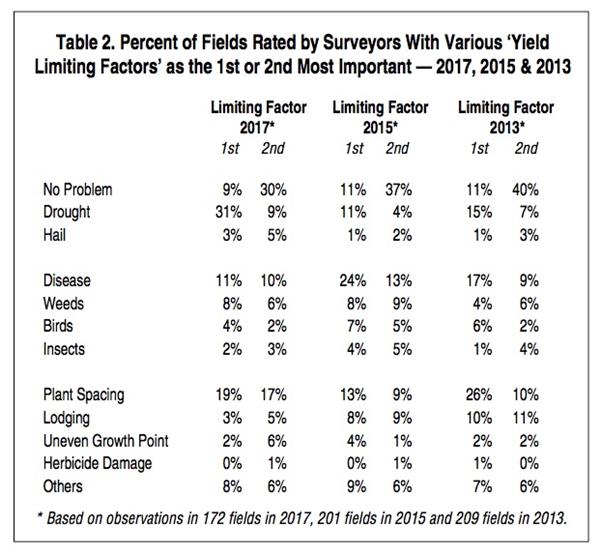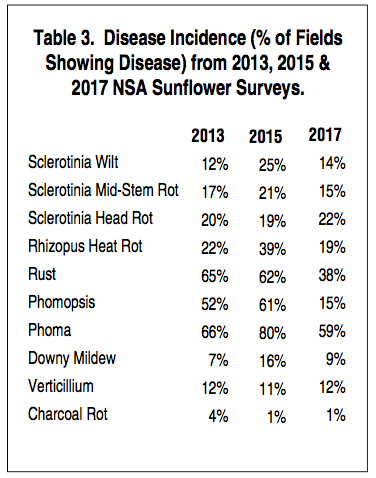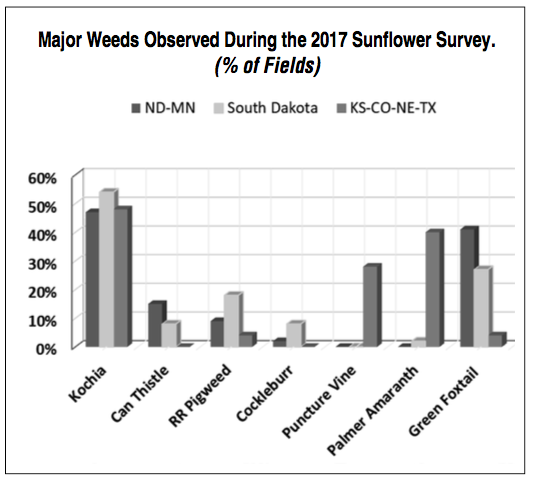In 2001, the National Sunflower Association had the foresight to coordinate a field survey that not only looked at yield, but also tabulated agronomic factors affecting yield — plus, examined all the diseases, insects and weeds that occurred in each field. That survey has continued to this day, initially every year and, starting in 2013, switching to a biennial event. The current survey, which encompasses the seven major sunflower producing states (North Dakota, South Dakota, Minnesota, Colorado, Kansas, Nebraska and Texas) and Manitoba, Canada, is the most comprehensive survey of any commodity — especially when one considers that it looks at 95% of the U.S. sunflower acreage and has been done 14 times, thus amassing a wealth of data allowing the NSA, public and private researchers to monitor not only what occurs in a given year, but also to see long-term trends and geographic differences.
The survey is also unique in that it is done entirely by volunteers, and they come from every segment of the sunflower community: university and USDA researchers, extension personnel and crop consultants, seed and chemical company personnel, NSA board members, and interested growers. All personnel receive first-hand instructions, either at regional workshops or by viewing webinars and other online training aids. A total of 75 people participated in 2017, divided into 26 teams. They inspected a total of 172 random fields, which represents roughly one field inspected for every 10,000 to 15,000 acres of sunflower in the major production counties.
A team typically spends 15 to 30 minutes tabulating 64 variables at two locations in each field. Six factors enter into yield estimates: plant stand, head diameter, seed size, % good seed, % center set and bird damage). Additionally, there are eight agronomic factors, 10 diseases, 10 insects and 30 weeds for which data are taken. The teams are also asked to subjectively determine which of 10 factors — ranging from Mother Nature (drought, hail) to biotic factors (weeds, insects, diseases, birds) to management factors (plant spacing, herbicide damage) — they feel are impacting yield. Since there may be more than one factor impacting yield, the team also records a second factor, if deemed necessary.
Finally, in 2017 seed samples were sent to Fargo USDA-ARS entomologist Jarad Prasifka for detailed insect testing with X-rays, and stalks were sent to South Dakota State University plant pathologist Febina Mathew to determine Phomopsis species.
For 2017, the average yield across the 172 fields in this survey was calculated to be 1,872 lbs/ac, with an average per-acre plant population of 16,320 (Table 1). Those numbers compare to 1,720 lbs/ac and 16,100 plants/ac in the 2015 survey. Yields ranged from 1,681 lbs/ac in Manitoba to 2,231 lbs in Minnesota.

The majority of U.S fields in the 2017 survey were dryland (94%), with the split between oil-type and confection fields being 80% vs. 20%. Tillage practices varied considerably by state, from 100% conventional tillage in Minnesota to 89% no-till in South Dakota. Survey-wide, the split was 65/10/25 for no-till, minimum till and conventional tillage, respectively.
Table 2 shows the most-limiting and second most-limiting factors for the period 2013 through 2017. The limiting factors are often different in the various states due to differences in climate, farming practices, rotations, etc. But, looking at the average over all surveyed states for the past three surveys, one notices that three factors are consistently judged to be those most impacting yield — namely diseases, drought and plant spacing. Thus, in 2017 drought the most significant factor impacting yield, noted in 31% of fields; while in 2015 disease was the most significant, noted in 24% of fields; and in 2013 plant spacing was #1, noted in 26% of fields.

The remaining six factors always were rated as yield limiting in less than 10% of surveyed fields. The yield limiting factors are grouped in Table 2 whether they are natural factors of which we have no control (e.g., drought, hail), biotic factors that can be managed through resistant hybrids or pesticide applications (disease, insects, weeds), or agronomic factors that can be managed by farming practices (plant spacing, herbicide damage, etc).
The plant spacing difficulties consist of large skips within the row or areas where plants grow too close together, causing some of the plants not to contribute to the sunflower yield. Equal distribution of plants is essential to obtaining maximum sunflower seed yield. Irregular plant distribution may have been caused by poor seeding conditions, failure to adjust the planter, driving too fast, poor germination, disease, insect damage, or other factors. Producers should pay attention to plant spacing issues, and planter calibration may be the first step to reducing skips and achieving more-uniform plant spacing.
While the overall yield average in 2017 was 1,872 lbs/ac, when one looks at the 9% of fields in 2017 where there was “No Yield Limiting factor,” the average yield in those fields was 2,110 lbs/ac, an increase of 13%. When those fields where drought, disease, weeds or plant spacing was the primary issue, the yields were decreased by 16, 20, 18 and 15%, respectively, from the 2,110-lb average of “No Yield Limiting factor” fields. This affirms that growers have the opportunity to increase yields in the latter three instances via management practices.
Disease incidence (% of fields affected) was lower for nearly all diseases in 2017 compared to previous years (Table 3). While drought likely was a major factor lowering diseases in some areas, one would like to think that wise management practices, resistant hybrids and responsible pesticide applications also helped to lower disease incidence.

Phoma black stem was in 2017, and has been in previous survey years, the most prevalent disease, found in 59% of surveyed fields. But this disease has had minimal impact upon yield. The other most prevalent diseases were rust, found in 38% of fields, and Sclerotinia head rot, found in 22% of fields. Rust was most prevalent in North Dakota (56%) and Texas (40%) and not observed in Manitoba. Sclerotinia head rot was highest in Manitoba and Minnesota, where it was observed in 100% and 63% of fields, respectively.
Phomopsis, which had become a major issue recently, was drastically lower in 2017. It was observed primarily in North Dakota, South Dakota and Minnesota (15, 21 and 20%), minimally recorded in the Central Great Plains (Kansas-Colorado-Nebraska) at 2%, and not observed in either Texas or Manitoba.
Of note, however, is what fungal species are responsible for Phomopsis stem canker. While originally thought to be caused by a single fungus, recent research in both the U.S. and Australia has determined that many Phomopsis species initiate this disease, and it is impossible to differentiate these species based on symptoms alone. Stalk samples sent to Dr. Mathew at her SDSU pathology lab were assayed using newly developed molecular methods, which allowed her to show that in two-thirds of the fields there were two species present.
With this information in hand, plant breeders will now look for genes that confer resistance to both species.
Broadleaf weeds continue to be more of a problem than grass weeds, as noted in previous surveys. The most prevalent weeds across all surveyed fields were kochia (47%), green foxtail (30%), Russian thistle (14%), redroot pigweed (12%) and Canadian thistle (12%). Some weeds were very regionally distributed, such as Palmer amaranth and puncture vine, found in 40% and 28% of fields, respectively, in the Central and High Plains states and not observed at all in northern growing states. The remaining 23 weeds monitored were observed in 2% or less of surveyed fields.

The 2017 survey also noted that insect damage was lower than in previous surveys. Sunflower midge, seed maggot and bud moth were uncommon and moderate in 2017 (in less than 30% of fields and with less than 5% of plants showing symptoms). However, the stem borer, Dectes texanus, was present in 48% of fields, with 15% of plants infested over the two Dakotas, an increase from 2015.
Clear trends were apparent from X-rays of the 162 seed samples submitted to the USDA-ARS laboratory in Fargo. First, red sunflower seed weevil was responsible for most of the seed-feeding losses. It was found in 46% of all samples. Second, the percentage of damaged seed was far lower in confection sunflowers, with < 1% damage over 34 fields, compared to 5% losses in oilseeds. Lastly, insect losses were concentrated in a small number of fields, with severe seed weevil infestations in the 12 most-damaged fields (19-59%) making up more than half of the seed damage observed over all the samples.
Bird damage was observed only in the northern region, with North Dakota, South Dakota, Manitoba and Minnesota having 60, 40, 33 and 25% fields affected, respectively. Average seed loss per head across fields with bird damage was 7%. (As the survey took place a few weeks before harvest, however, it is very likely actual bird damage numbers at harvest were higher.)
The data generated in the National Sunflower Survey can be used by producers to help make better management decisions. Researchers, whether USDA, university, seed or chemical company, will use this information to guide their future research. Lastly, the National Sunflower Association relies on this continued stream of field data to determine which research areas to fund in an attempt to make U.S. sunflower production more profitable.
Tom Gulya - Research plant pathologist (retired), USDA-ARS; Ryan Buetow - Extension cropping systems specialist, North Dakota State University; Hans Kandel - Extension agronomist, North Dakota State University; Febina Mathew - Plant pathologist, South Dakota State University; Jarad Prasifka - Research entomologist, USDA-ARS.